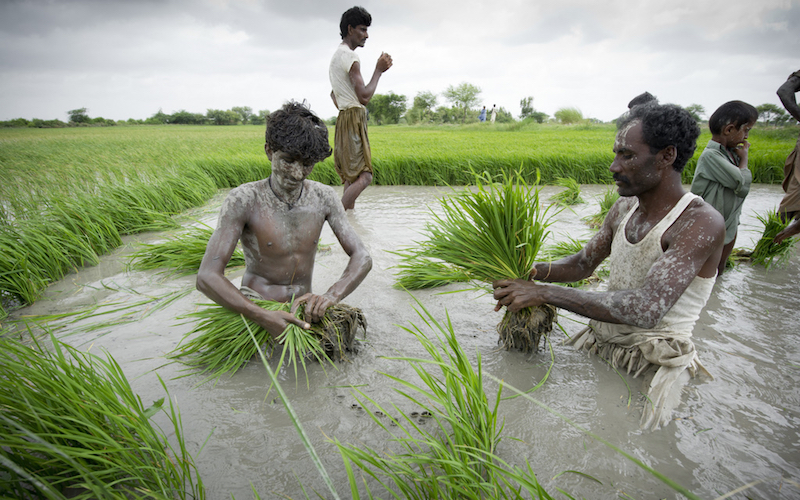
Slump in Basmati Rice Exports Causing Problems for Pakistan
A slump in the export of basmati rice is having a damaging effect on the Pakistani economy. It has exacerbated rural poverty with often catastrophic consequences for small farmers. The causes of the slump are complex and both national and provincial governments are facing criticism for a failure to act.
Pakistan’s exports of basmati rice have declined by 40% in the past four years, from 1.1mn tons in 2011 to 676,630 tons in 2015. As a consequence, the domestic market has been overwhelmed by an unmanageable glut, with an accumulated surplus of 1mn tons. This has driven down the domestic price of rice by 50%, from Rs4500 per maund (a measure equal to 40 kilos) in 2012 to Rs2200 per maund in 2015. If the surplus is not reduced, there are fears of a further collapse in domestic prices, which would deter farmers from growing basmati.
In Pakistan basmati has traditionally been an export crop. In recent times, 60% of the total annual production of 2mn tons produce has been sold abroad, generating around $2bn for the national economy, boosting foreign currency reserves and contributing to a healthy balance of payment (BoP). The basmati trade has played a major role in the alleviation of rural poverty, so much so that the rice crop is seen as too important to be left to the mercy of market forces.
In previous years, the Pakistani government gave the task of removing the glut from the domestic market to the Pakistan Agriculture Storage and Supplies Corporation (Passco) and to the Trading Corporation of Pakistan (TCP). It seems, however, that neither organization is now fulfilling this role, and the national government has been accused of neglecting its duty to regulate the market, both in terms of inputs and export of the produce.
The responsible departments of the federal government, the Trade Development Authority of Pakistan (TDAP) and the Ministry of Commerce, have failed to act, as has the provincial government agriculture department of Punjab, to which responsibility for agriculture was devolved under the 18th constitutional amendment.
In the same period that Pakistani basmati exports declined by 40%, Indian exports increased by 50%. The export figures for India rose from 2.37mn tons in 2011 to 3.45mn tons in 2013, an increase of 1.2mn tons that is estimated to include 400,000 tons of exports won from Pakistan through competitive advantage. The fact that India added a further 800,000 to its exports clearly disproves any argument that basmati is losing its appeal in the international market.
One of the main reasons for Pakistan’s loss of international competitiveness is the low yield rates, which have been stagnant at 25-30 maunds per acre. The variety of seed used in Pakistan was developed in the mid-1990s and is now susceptible to pests and diseases that decrease the yield. This has reduced economies of scale, pushed up production costs and made the export of Pakistani basmati uncompetitive. The research institutes (Pakistan Agriculture Research Corporation, National Agriculture Research Corporation and Rice Research Institute) have so far failed to develop a new variety of seed that would increase yields.
Electricity shortages have also increased the cost of production because some rice mills are operating at only half their capacity, and gas shortages make the drying process longer. The deterioration in law and order in Karachi, the major port city, has increased the cost of shipping and hindered exports. Transporters have been targeted by criminal gangs who demand protection money for every container and sometimes hijack transport vehicles.
The Rice Export Association of Pakistan (REAP) is seen as focusing on maximizing short-term profits, rather than investing in the development of exports. The Indian private sector, by contrast, has made long-term investments not only in retail brand development, with aggressive marketing for exports, but also in research and development of new seed. Two of its recently developed seed varieties, which have increased production and exports, were produced by the industry. In contrast, Pakistan’s exporters are more interested in maximizing short-term profits and one way of doing this has been to dump basmati rice in countries at the lower end of the market. The rice is then often snapped up at a low cost by other nations, particularly India, thus strengthening their retail brand.

Dumping rice in the international market results in a low price for exports, while the domestic price of rice is high because of the high cost of production and low yields. Exporters and domestic traders have been accused of ensuring cheap supplies for export by manipulating the market and engineering a domestic market crash. In 2008 the government tried to impose a minimum export price (MEP), but within four months it had bowed to pressure from the exporters and abolished the MEP. India, by contrast, has kept its MEP and has seen exports double between 2007-2010, from 1.2mn to 2.4mn tons.
The inefficiencies in the rice trade make it crucial for the government to regulate the market, instead of allowing prices to be manipulated by a few players under the guise of free market forces.
Pakistani basmati rice has its niche in the world market because of its natural taste and aroma, and the world is prepared to pay a premium for this. It strengthens the case for the crop to be protected and exports to be developed. Unfortunately, the market crash will discourage farmers from growing basmati. This will diminish the area under rice cultivation with adverse consequences for rural livelihoods and the economy as a whole.
Pakistani exports have suffered from bans by Russia, Mexico and Iran in recent years. These were the result of failures to fulfill quality standards, with pests being found at the initial monitoring stage or in consignments. The international market is an extension of the domestic market, improving the quality in the domestic market is fundamental to the development of exports. Ensuring, for example, that seeds of different varieties are kept separate and establishing proper quality standards is essential to ensure long-term buyers’ confidence.
REAP has a monopoly for the export of rice and the government has made membership of the body mandatory for rice exporters. But with the power of monopoly comes the responsibility to develop exports and retail brands. Brand development is an expensive exercise, but it benefits the country, province, farmers and the traders. Successful retail brand development can not only increase the share of the market, but can also increase the value of exports by up to 400%.
The 18th constitutional amendment made the provincial governments solely responsible for the agriculture sector, and the Government of Punjab needs to learn lessons from the federal government’s failure to develop the export of rice. If REAP is failing to invest in brand development, the Government of Punjab should develop its own brand. This would foster positive presentation of the trade and bring long-term benefit to both the province and the country.
The rice crop roughly utilizes approximately 17 million acre feet (maf) of water, which agricultural economists value at $34bn. The consumption of a precious natural resource on such an enormous scale demands that particular care be paid to water planning, to the impact of the rice trade and to the responsibility of the government and exporters to fully capitalize on rice exports.
Unfortunately this has not been the case in recent years. Instead of taking responsibility, exporters and traders blame the government and the farmers for using archaic seeds and production methods. They have opposed official intervention in the trade cycle, claiming that setting an MEP subsidizes inefficiencies. For their part, farmers blame the traders for pressuring the government to abolish the MEP and to procure rice to clear the glut.
All this is in sad contrast to what has been happening in India. One might conclude that Pakistan could learn useful lessons from India’s success in creating a win-win situation for farmers, exporters and the economy. The first step would be to expand the share of rice going to the export market, which demands a multi-pronged strategy starting from reforms in the domestic market to a specialized approach to marketing in the international market.
Special thanks to Mr. Ahmad Fraz Khan for his valuable insight.

